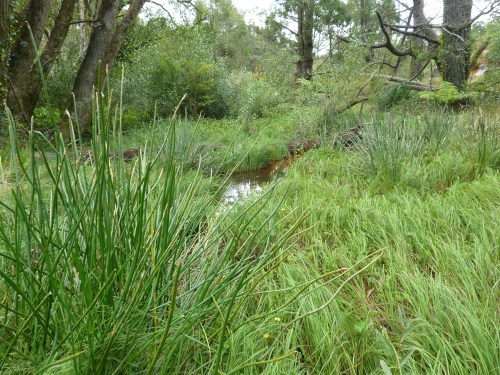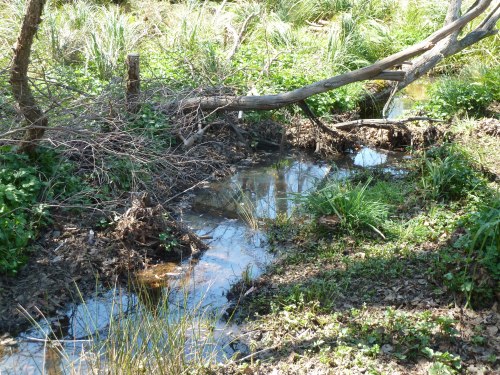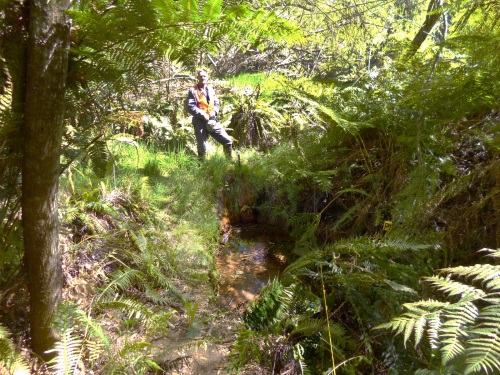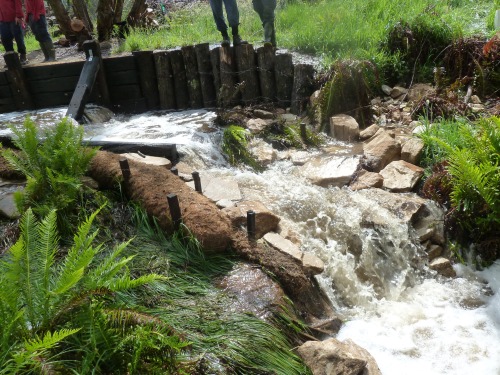Alan Lane
Key words: urban stream, erosion, siltation, soft engineering, head wall
Introduction: Popes Glen Creek is a small permanent stream rising close to the centre of the township of Blackheath, NSW, Australia. Its upper catchment (10 ha) comprises low-permeability urban development, roadways, shops and parklands.
The funneling of runoff from the low-permeability catchment into the headwaters of Popes Glen Creek resulted in intense and destructive runoff after rain, carrying down large and small debris, depositing sheets of silt, uprooting or burying vegetation, causing erosion of the creek banks and threatening to undermine the head wall of the silt flat downstream. This resulted in the formation of a 1 ha silt flat at the headwaters of the creek, covered with dense infestations of mature Crack Willow (Salix fragilis), Purple Ossier (S. purpurea) and mid-storey and ground-layer weeds. This has been revegetated as a permanent wetland as described in a previous summary (https://site.emrprojectsummaries.org/2015/02/22/)
This summary describes the runoff management aspects of the project, where the aims were:
- to reduce the impact of runoff
- to reduce the incursion of silt
- to remediate the main channel
- to stabilise the head wall.
Works carried out:
1. Diversion of part of the flow and capturing sediment. A diversion channel was constructed with flow regulated by a notched weir in the main stream. This diverts approximately half the volume of the flow into a sedimentation pond were silt is captured, reducing the quantity deposited downstream (Figures 1 and 2).
2. Construction of low-impact detention cells. “Soft engineering” detention cells constructed across the silt flat from coir logs and woody debris found on site retain and slow the release of flow, dispersing it across the silt flat and raising the water table, suppressing weeds and supporting the vegetation of the created wetland (Figures 3 and 4).
3. Elimination of the highly incised main channel. Natural debris falling into the main channel creates a series of small pondages. These retain and slow the flow and allow overflow to disperse across the silt flat. (Figure 5).
4. Protection of the creek banks. Dense plantings of deep-rooted swamp vegetation e.g. Red-fruited Saw Sedge (Gahnia sieberiana) and Black Wattle (Callicoma serratifolia) (Figure 6), and loosely woven structures constructed from woody debris (Figure 7) protect creek banks and silt flat from erosion and scouring.
5. Stabilisation of the headwall. Contractors employed with funds from the Environmental Trust have constructed a major structure with railway sleepers and rock armouring to stabilise the head wall (Figures 8 and 9).

Figure 4: Raised water table enabled wetland sedges (Carex gaudichaudiana and Eleocharis sphacolata) to displace Creeping Buttercup (Ranunculus repens).
Lessons learned and future directions: This project is on track to replace the forest of willows with wetland vegetation, transform a highly incised creek and weed-infested silt flat into a healthy Upper Blue Mountains Swamp – an endangered ecological community scheduled under the Commonwealth’s Environment Protection and Biodiversity Conservation Act 1999.
The volunteer group will continue working with Council and contractors to complete the planting program and to monitor the evolution of the site, including its vegetation, water quality and colonisation by macroinvertebrates, birds and frogs.
Stakeholders and funding bodies: This work is supported by a grant from the Government of New South Wales through its Environmental Trust and by the Blue Mountains City Council, which also oversaw the engineering works. All photographs: Alan Lane and Paul Vale.

Figure 6: Dense plantings of Black Wattle (Callicoma serratifolia) and Gahnia (Gahnia sieberiana) protect creek banks from erosion.
Contact information: Dr Alan Lane, Coordinator Popes Glen Bushcare Group, PO Box 388, Blackheath NSW 2785, Australia. Tel: +61 2 4787 7097; Paul Vale, Deputy Coordinator Popes Glen Bushcare Group, 81 Prince Edward St, Blackheath NSW 2785, Australia. Tel: +61 2 4787 8080; and Ray Richardson, Chairman of Steering Committee, Environmental Trust Grant 2011/CBR/0098. Tel: +61 2 4759 2534.











